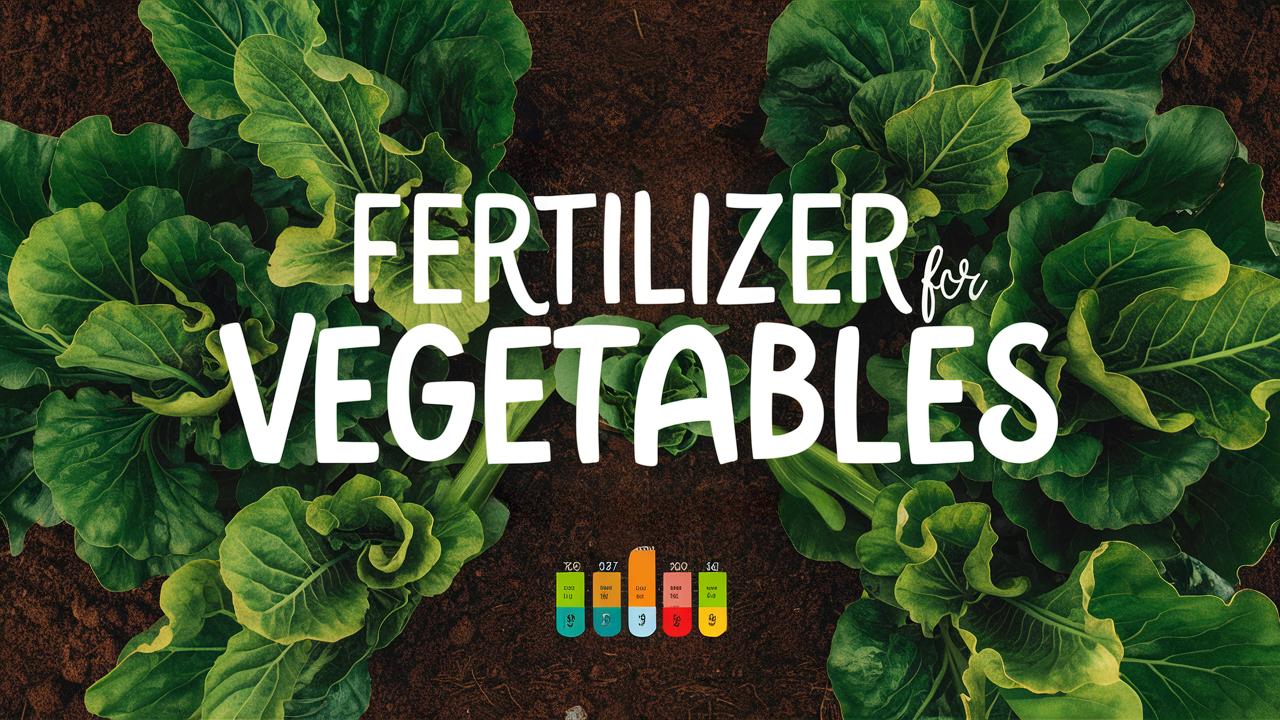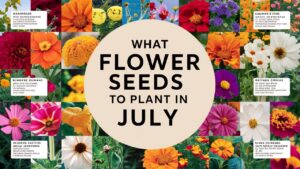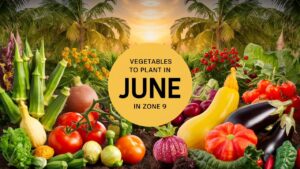This guide will walk you through the complexities of selecting a fertilizer tailored to your vegetable garden’s unique needs.
Fertilizer For Vegetables
| Image | Name | Rating | Shop |
|---|---|---|---|
 | Osmocote |  | |
 | 10-10-10 NPK Fertilizer |  | |
 | Garden Nutrients |  |
Osmocote
If you’re looking for a fertilizer that can provide long-lasting nutrients to your vegetable gardens, we recommend the Osmocote Smart-Release Plant Food Flower & Vegetable, 8 lb. This product has a high total nutrient formula of NPK = 14-14-14, making it perfect for promoting strong roots and vigorous above-ground growth in seasonal vegetables and perennials.
This fertilizer is also easy to use – simply mix 1 lb. into 1 – 3” of soil for every 40 sq. ft. (approx. 6½’ x 6½’) of space. The included applicator makes it simple to apply the product evenly throughout your garden or raised beds. Plus, with its slow-release formula and natural replenishment process, Osmocote Smart-Release Plant Food Flower & Vegetable is virtually mistake-proof – even if you over-apply by up to 3x the recommended rate, it won’t “burn” your plants.
10-10-10 NPK Fertilizer
If you’re looking for a reliable fertilizer for your vegetable garden, consider GreenView’s Multi-Purpose Fertilizer. It has a balanced NPK formula of 10-10-10, which means it provides equal amounts of nitrogen, phosphorus, and potassium to promote healthy growth.
Garden Nutrients
The Down to Earth Organic Vegetable Garden Fertilizer is a great choice for anyone looking to maintain a healthy and thriving vegetable garden without harming the environment.
This fertilizer is made from all-natural ingredients and has a slow-release formula that delivers nutrients gradually to promote long-lasting support for your plants. It’s also safe for beneficial insects, pollinators, pets, and the surrounding ecosystem, making it an excellent choice for gardeners who want to minimize their environmental impact.
Fox Farm Organic Vegetable Fertilizer
This product is suitable for those looking for a reliable fertilizer for their vegetables. Fox Farm’s Happy Frog Tomato and Vegetable Fertilizer is specifically designed to support the growth of tomatoes, veggies, soft fruits, and berries. The dry formula makes it easy to store and apply.
The unique blend of 5-7-3 ratio nutrients, including high phosphorus, promotes healthy plant growth and root strength. Additionally, the inclusion of mycorrhizal fungi and calcium support resilient plants that can resist diseases and thrive in various conditions. For those interested in organic gardening practices, this product aligns with eco-friendly methods for naturally nourishing your plants.
Burpee Organic All Purpose Granular Plant Food
We recommend using Burpee Organic Tomato & Vegetable Granular Plant Food as a fertilizer option for your vegetable garden. This product is specifically designed to provide long-lasting results, releasing essential nutrients immediately and continuing to feed the plants for up to 3 months.
The granules in this fertilizer contain all the necessary nutrients for optimal growth, allowing your vegetables to produce superior results throughout the season. Plus, it’s OMRI listed for organic use, making it a great choice for gardeners who want a pesticide-free and eco-friendly option. With Burpee’s reputation for delivering high-quality products since 1876, you can trust that this fertilizer will help your vegetables thrive.
Miracle-Gro Shake ‘N Feed
Miracle-Gro Shake ‘N Feed Tomato, Fruit and Vegetable Plant Food is a product worth considering when it comes to fertilizing your vegetable garden. This plant food has been specifically designed to feed plants for up to 3 months, making regular application a breeze. The nutrient-rich formula contains calcium, which helps strengthen the plant’s walls, leading to higher quality and longer-lasting fruits and vegetables.
One of the standout features of Shake ‘N Feed is its versatility – it can be used on a variety of plants, including tomatoes, fruits, and leafy greens in both in-ground and container gardens. Application is relatively simple: just sprinkle the product evenly onto the soil and water to start feeding your plants. Reapplication every 3 months will ensure that your garden continues to thrive all season long. The natural ingredients in this formula also provide an added boost of nutrition, helping you grow healthier and more resilient vegetables than those without fertilization.
Organic Vegetable and Tomato Fertilizer Grains by Jobe’s
For your vegetable garden, consider using Jobe’s Organics Granular Garden Fertilizer. This product is designed with an easy application process in mind, so you can maintain a healthy and robust garden without much hassle.
This fertilizer meets all the necessary requirements for organic gardening and comes with OMRI listing from the USDA. The NPK ratio of 2-5-3 provides a balanced blend of nutrients for optimal vegetable and tomato plant growth, ensuring high yields and vibrant foliage throughout the seasons. Simply sprinkle it around your plants every 4-6 weeks or as needed to provide them with the essential nourishment.
Scotts Continuous Release Plant Food
This is a solid choice for vegetable gardening needs due to its all-purpose formula that covers flowers and veggies alike.
Using this product, you can expect continued plant nourishment thanks to its continuous release nitrogen feeding which lasts up to two months at a time. Plus, the recommended coverage area per bag means it’s suitable for small areas around your garden or bigger spaces depending on your needs. Just be sure to follow the application instructions provided on the label and rake into the topsoil after sprinkling. This 3-pound bag covers approximately 150 square feet of garden space, making it a convenient solution.
Garden-tone
Garden-Tone organic fertilizer from Espoma is a popular choice among gardeners looking to grow healthy and flavorful vegetables. This 3-4-4 formula is designed for use on both cool and warm season crops, making it a versatile option for gardens with a mix of different plantings.
We recommend Garden-Tone because of its environmentally safe ingredients and ease of use. The Bio-tone formula in Garden-Tone provides a rich blend of natural nutrients that promote strong root growth and healthy foliage. Plus, it’s ready to use right out of the bag – no mixing required! As an added bonus, Garden-Tone is approved for organic gardening, making it a great choice for gardeners committed to sustainable practices.
Old Farmer’s Almanac Organic Tomato & Vegetable Plant Food
If you’re looking to give your vegetable garden the best possible start this season, consider using The Old Farmer’s Almanac Organic Tomato & Vegetable Plant Food Fertilizer. This fertilizer is designed specifically with tomatoes and vegetables in mind, making it a great choice for those of us who grow our own food at home.
The Old Farmer’s Almanac has been providing trusted gardening advice for generations, so you can be sure that their fertilizer is made with only the best ingredients that are gentle on your soil while helping to promote healthy growth in your vegetables. Whether you’re a seasoned gardener or just starting out, this organic fertilizer makes a great choice – and at no cost description we can’t find out what benefits you’ll get from using it so just go for try and see if its good enough for you.
Miracle-Gro Performance Organics Edibles Plant Nutrition
Miracle-Gro Performance Organics Edibles Plant Nutrition is a good choice for fertilizing vegetables and other edible plants because it’s OMRI listed as an organic product, making it suitable for gardens that are transitioning away from synthetic fertilizers but need the extra nutrients for a bountiful harvest. Using this plant food will promote healthy growth in your tomato, vegetable, herb, or fruit garden.
The Miracle-Gro Performance Organics Garden Feeder can be used to make application easy and convenient, or you can use a watering can if that’s more manageable for your garden space. For maximum effectiveness consider feeding your garden regularly, every seven days is optimal but this will depend on how much growth is going on in the garden as some plants can use more nutrients during certain stages of development.
Down To Earth All Purpose Mix
For a reliable and all-purpose fertilizer for your vegetable garden, consider the Down To Earth All Natural Fertilizers Organic All Purpose Tomato & Vegetable Mix 4-6-2. This formula is designed to provide a consistent supply of essential nutrients to your plants, while also promoting healthy soil fertility and microbial activity.
The OMRI-listed ingredients in this fertilizer are all-natural and won’t burn your plants even with application mistakes. The combination of premium organic ingredients such as Fish Bone Meal, Blood Meal, Feather Meal, Rock Phosphate, Langbeinite, Greensand, Humates and Kelp Meal ensure that your vegetables receive a balanced supply of nutrients needed for healthy growth. Suitable for various gardening needs including vegetable gardens, containers, houseplants, trees, shrubs and row crops/acreage.
How To Choose a Fertilizer For Vegetables: A Comprehensive Guide
Growing your own vegetables can be an incredibly rewarding experience, both for your palate and your pocketbook. Fresh produce from your garden is not only tastier but also more nutritious than what you might find at the supermarket. However, to ensure your garden flourishes, understanding how to choose the right fertilizer is crucial.
Understanding Fertilizer Basics
Before diving into the specifics of vegetable fertilizers, it’s essential to grasp what fertilizers are and why they are critical for your plants. At its core, fertilizer is a substance that provides essential nutrients to plants, helping them grow stronger, healthier, and more productive.
Nutrient Components
Fertilizers primarily provide three key nutrients:
Nitrogen (N): This nutrient promotes leafy growth and is particularly crucial for leafy vegetables like lettuce, spinach, and kale.
Phosphorus (P): Important for root development and flower/fruit production, phosphorus is vital when growing crops like tomatoes and peppers.
Potassium (K): This nutrient supports overall plant health and disease resistance, impacting the quality of the produce.
These three nutrients are often referred to as N-P-K, and you’ll typically see their ratios printed on fertilizer bags (e.g., 10-10-10 or 5-10-5).
Understanding Soil Health
Before you even consider choosing a fertilizer, get to know your soil. Soil is alive with microorganisms that contribute to your plants’ health, so it’s essential to understand its basic makeup. Testing your soil for pH levels and nutrient content is a wise first step.
Soil pH: Most vegetables thrive in slightly acidic to neutral soil (pH 6.0 to 7.0). Test kits are available at garden centers or through local agricultural extensions. If your soil is too acidic or alkaline, you might need to amend it before considering fertilizer.
Soil Nutrient Levels: Soil tests can also reveal nutrient deficiencies. Based on these results, you can better determine the kind of fertilizer your vegetables need.
Types of Fertilizers
Once you’ve got your soil tests and pH figured out, the next step is to understand the different types of fertilizers available. They primarily fall into two categories: organic and inorganic.
Organic Fertilizers
Organic fertilizers are derived from natural sources and can improve soil health in addition to providing nutrients. Common examples include:
Compost: Rich in nutrients and beneficial microbes, compost improves soil structure and moisture retention.
Bone Meal: A great source of phosphorus, this is particularly beneficial for root development.
Fish Emulsion: Packed with nitrogen, it’s wonderful for leafy crops and can be easily absorbed by plants.
Manure: A classic organic source of various nutrients. Make sure it’s well-aged to minimize the risk of burning plants.
Organic fertilizers not only nourish your plants but also enhance soil health over time, although they often release nutrients more slowly than synthetic options.
Inorganic Fertilizers
Inorganic or synthetic fertilizers are manufactured and may offer a more concentrated nutrient profile. They can be applied directly to provide an immediate nutrient boost, making them an attractive option for quick results. Examples include:
Urea: This synthetic nitrogen source is often used to promote lush, green growth.
Superphosphate: Used to accelerate root and fruit development with its high phosphorus content.
Potassium Sulfate: A preferred source of potassium that also aids in boosting plant health and disease resistance.
While these fertilizers can lead to rapid growth, they can also sometimes lead to nutrient runoff, which could harm local ecosystems.
How to Match Fertilizer to Vegetable Needs
When deciding how to choose a fertilizer for vegetables, consider what you are growing and its specific nutrient needs.
Leafy Greens
For crops like spinach, lettuce, and kale, which thrive on nitrogen, a fertilizer higher in nitrogen (e.g., a 20-10-10 ratio) would be ideal. Organic options such as blood meal or fish emulsion can provide that nitrogen boost without the risk of over-fertilization.
Root Vegetables
Carrots, beets, and potatoes benefit from balanced nutrition. A fertilizer with equal parts N, P, and K (like a 10-10-10) will encourage healthy root growth. Organic matter like compost or well-rotted manure is also beneficial for improving soil texture and providing a gradual nutrient release.
Fruit-bearing Vegetables
Tomatoes, peppers, and cucumbers all require more phosphorus and potassium to produce fruit. A fertilizer such as 5-10-10, which emphasizes phosphorus and potassium, would work well. Additionally, mixing in some bone meal or using a fish emulsion can assist in developing a fruitful crop.
Legumes
Beans and peas have a unique advantage; they can fix atmospheric nitrogen in the soil thanks to their root nodules. Therefore, they require less nitrogen-rich fertilizer and can benefit more from phosphorus and potassium.
Timing is Everything
Understanding when to fertilize your vegetables is just as crucial as choosing the right type. Most plants benefit from fertilization at specific points in their growth cycle:
Before Planting: Incorporate organic matter and basic fertilizers into the soil before planting seeds or seedlings. This creates a nutrient-rich environment to promote germination and establishment.
During Growth: Mid-season, your plants may require additional nutrition, especially if they show signs of nutrient deficiency (like yellowing leaves). Side-dressing with organic fertilizers or a liquid feed can provide the necessary boost.
Before Harvest: As vegetables start to mature, reduce or eliminate nitrogen to prevent excessive leaf growth and encourage fruit development.
Application Methods
How you apply fertilizer is just as important as what you apply. Here’s a breakdown of common application methods:
Broadcasting
This method involves spreading granular fertilizer over the surface of the soil. This is effective for many vegetables but requires rain or irrigation to help the fertilizer penetrate the soil.
Side-Dressing
This technique involves applying fertilizer in bands alongside growing plants. It’s particularly useful for heavy feeders like corn or tomatoes, allowing for direct nutrient uptake without disturbing the plant roots.
Foliar Feeding
This method entails spraying a diluted fertilizer solution directly onto the leaves of plants. It’s an excellent way to provide a quick nutrient boost, especially for micronutrients. However, it should not replace soil fertilization.
Fertigation
Common in larger-scale operations, fertigation involves mixing fertilizers with irrigation water. This ensures that nutrients are delivered directly to the root zone, where plants can absorb them most effectively.
Environmental Considerations
When choosing a fertilizer, consider its environmental impact. Overuse of chemical fertilizers can lead to soil degradation, nutrient runoff, and water pollution. Opt for organic fertilizers whenever possible and practice crop rotation and cover cropping to restore soil health. Additionally, understanding the local ecosystem and working with it can contribute to a sustainable gardening approach.
Understanding Labels and Claims
When you’re shopping for fertilizers, the labels can be overwhelming. It’s essential to understand what the various claims and numbers mean. Look for:
N-P-K Ratio: This tells you the percentage of nitrogen, phosphorus, and potassium in the fertilizer. Choose based on your vegetable’s needs.
Slow-Release or Fast-Release: Slow-release fertilizers provide nutrients gradually, making them ideal for long-term feeding, while fast-release options deliver immediate results.
Certified Organic Label: If you choose organic fertilizers, check for official certification to ensure the product meets organic standards.
Troubleshooting Fertilizer Issues
You may encounter problems even after applying the right fertilizer. Here are some common issues and solutions:
Over-Fertilization
If your plants exhibit signs of excessive growth but have poor fruit or vegetable set, you may have over-fertilized. Symptoms include burnt leaf tips and leaf drooping. If this happens, reduce the frequency of application, rinse the soil with water to leach excess nutrients, and be cautious with future fertilization.
Nutrient Deficiencies
Yellowing leaves, stunted growth, and poor yields can indicate nutrient deficiencies. Identifying specific deficiencies involves observing your plants and conducting soil tests. Adjust your fertilizer depending on the deficiency—consider adding compost or targeted fertilizers.
Poor Soil Health
If your plants are struggling despite fertilization, the soil itself may be unhealthy. Incorporate organic matter, practice crop rotation, and minimize soil disturbance to improve soil structure and microbiota.
Closing Thoughts
Choosing a fertilizer for your vegetables is not just about nutrient ratios and application methods; it’s about understanding your plants’ needs and the specific conditions of your garden. By combining knowledge of soil health, nutrient requirements, and careful timing, you can create a thriving vegetable garden that will provide you with bountiful harvests.














